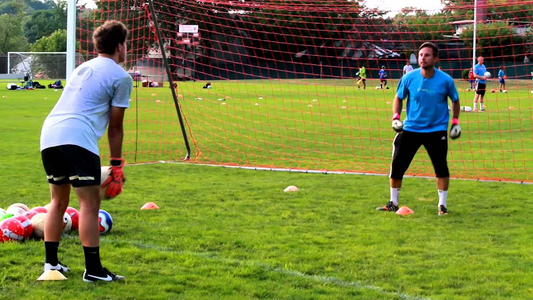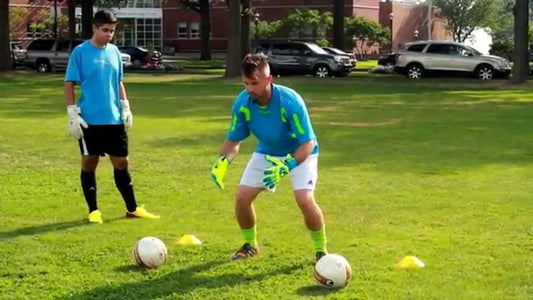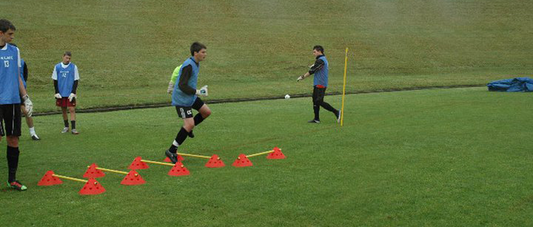Goalkeepers need good footwork to get their body into position to make the correct save. Our hands make the save, but our feet get us there. Quality training on footwork will improve all goalkeepers and should be trained on the soccer field daily. We can improve our footwork with little to no equipment and you certainly don't need a soccer field. The only limit will be your imagination. Staying on your toes and sharpening your movement will see you make more saves and be more efficient in the goal.
Goalkeeper Footwork
Goalkeeper Footwork and Handling Warm Up
A great pre game or practice goalkeeper footwork and handling warm up exercise. There are many variations that could be added. Watch the Keeperstop YouTube video and let us know what you think.
Feet vs Hands, Training a keeper's feet will help the catch more and dive less.
The success or failure of any goalkeeper revolves around their ability or inability to move their feet, get set or deal with a situation. It simply does not matter that you have the softest hands in the world if your feet do not get those “soft” hands to the ball. But, once you can get there and get set, these hands are the next critical step in having success. Yes, I agree there are a lot of other very important aspects of the game that the goalkeeper needs to possess (reading the game, communication, distribution, etc.), but without good feet and hands, everything else is a mute point.
If you watch top-level goalkeepers, they always seem to be in the right position, make easy saves and dive very little. Well, it is not just a coincidence that this happens. They have great feet that are quick, agile and strong. Oh yeah, and they have great hands that typically catch everything within their grasp with little rebounds or dropped balls. This is the true mark of a quality goalkeeper.
It amazes me how many goalkeepers and trainers want to spend most of their goalkeeper training diving after balls…why would you want to dive if you do not need to? Why not work on your feet more so you do not need to dive all the time? Thus saving your body from injury and being able to put the ball back into play quicker by already being on your feet. Myself as a former pro can say that the majority of my training revolved around moving my feet, getting set and dealing with simple shots. YES, simple shots! Balls that I could handle and catch cleanly were the majority of my repetitions. The reason? To stay technically sharp and gain very valuable confidence prior to upcoming matches. This important confidence element is crucial to any goalkeeper. Simply stated, confidence is going to come from being able to do simple things well. Most pros train the same way by keeping things simple…if you ever get the chance to watch a pro train I would highly recommend it. You will be amazed at how simple the training is and how easy they make it look.
How can we work on our feet? The first thing you can do is try to find a local speed and agility trainer around your area. Most fitness centers currently offer this type of programming and I highly recommend it. Your training will consist of a lot of cone work, speed ladders, mini hurdles, etc. Once you get comfortable with your feet and they are becoming quicker, we must then begin to bring these exercises into your goalkeeper training and incorporate them with your hands. For example, moving your feet quickly through a few cones to get set, deal with a shot and handle it clean. A golden rule in our program is to keep everything below your waist quick and above the waist very RELAXED…the reason? We need our feet to get us places quickly and get set, but our upper body is what we catch the ball with and it needs to be soft and relaxed. RELAX, RELAX, RELAX with your hands and upper body!
Do not be afraid to make up your own exercises and test your feet in your own way. As long as you are moving your feet and then getting them set, you will be fine. We tell our goalkeepers in our program that you simply cannot catch enough of balls in the course of the day. Get as many quality repetitions in as you can and you will see the benefits in your play in matches!
ONE on ONE Soccer Goalkeeper School (National) - www.ONEonONEsoccer.com, National Director - Todd Hoffard The Goalkeeper School is by far the most technical environment you can find in the nation. We are the only staff that is made up entirely by Division I college coaches, regional/national team coaches and or professional goalkeepers. Also, we monitor our goalkeepers for the entire year to follow their development.
The Importance of Footwork for Goalkeepers
Footwork is an essential aspect of a goalkeeper's repertoire. A goalkeeper's footwork can prove the difference between saving the game or letting one slip into the back of the net. Quality goalkeepers develop footwork early in their careers and perfect it throughout. Developing footwork cannot be rushed. It takes consistent and quality training that cannot be fudged. Focus and attention to detail is key and technique must be developed over time so when the time comes, and the goalkeeper’s ability to move across the goal is tested, they can quickly react at a moments’ notice.
Footwork is also one of the more difficult techniques to master. In the majority of cases, a goalkeeper is forced to dive for a shot when either the ball has been hit with pace and accuracy or when the goalkeeper has been caught out of position. When working on developing their footwork, a goalkeeper should focus on:
Their steps and stride length (shorter distances, small steps, larger distances, bigger steps)
Limit crossing one foot over the other
Staying in line with the ball
Keeping their hands prepared for the shot
Remaining in a ready position while moving
Maintaining that their hips and shoulders should remain square to the ball
Staying on the balls of their feet (front part of their feet)
Positioning themselves behind the ball
Footwork moving in a positive or forward direction
Frequent mistakes goalkeepers make in their footwork include:
Not positioning their body behind the ball
Leaning back on their heels
Feet crossing over each other
Stepping backwards on a save
Not preparing their body to be in a ready positioning while they are conducting footwork exercises
Below are a few exercises that will assist in developing a goalkeeper's footwork. As you will see, the drills incorporate a ball whenever possible. I encourage utilizing balls in training as it replicates the goalkeeper's activities in games and can allow feedback to the coaching points discussed above.
Exercise: Goalkeeper starts in center of box designated by a red cone. Coach labels all orange cones 1-4. Coach calls out number, keeper quickly goes and touches that cone and gets back to center of box to receive a ball from the server.Exercise: Goalkeeper starts in center of box designated by a red cone. Coach labels all orange cones 1-4. Coach calls out number, keeper quickly goes and rounds that cone and gets back to center of box to receive a ball from the server.Exercise: Goalkeeper starts in center of box designated by a red cone. Coach labels the sides of the box north-south-east-west. Coach calls out either one of those and keeper quickly goes out to that side completely passed the cones and gets back to center of box to receive a ball from the server.
Exercise: Goalkeeper moves laterally side to side. Servers alternate taking volleyed strikes at the goalkeeper. Keeper quickly collects ball and tosses ball back to server, moves laterally and receives ball from other server and repeats. With multiple keepers, use them as servers and they can focus on their distribution technique.
Variation:
Keeper moves across the goalmouth to receive the first ball volleyed, returns that ball to the server and moves to collect the other ball from the second server who tosses the ball in the air and off the goalkeeper’s line so they must moves forward to collect the ball at the highest point.
Coaching Points:
Quick Balanced Steps
Hands and Body in ready position
Get into line with the ball when receiving
Body weight on the balls of their feet, almost leaning forward
Limit crossover steps and when they are used make sure the keeper keeps their hips and shoulders square to the ball
Exercise: Goalkeeper starts with ball on end line. Goalkeeper starts on near post (slightly in front). Server plays ball to goalkeeper on ground. Keeper receives ball and plays ball in advance of the keeper as keeper moves in an arcing position across the top of the goal mouth striking balls ending up on the other side of the goal on the end line. Each time ball comes to servers feet, they strike a ball at keeper.. Keeper adjusts his angle accordingly. Once reaching the end line on the opposite side, the server repeats in the opposite direction.
Coaching Points:
Staying in line with the ball
Keeping their hands prepared for the shot
Remaining in a ready position while moving
Goalkeeper’s hips and should remain square to the ball
Staying on the balls of their feet (front part of their feet)
Goalkeeper should make sure they position themselves behind the ball Rob Parker is Assistant Women’s Soccer Coach at Union College. NSCAA National Goalkeeping Diploma, a NSCAA Advanced Regional Diploma and a USSF National "D" Coaching License. He is also a former member of the Eastern New York ODP staff. Twitter: @goaliecoach00 Email: rbrtprkr@yahoo.com
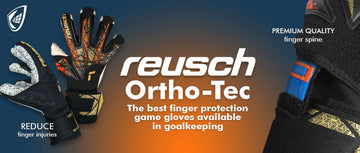
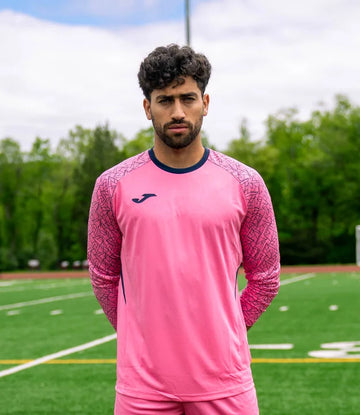
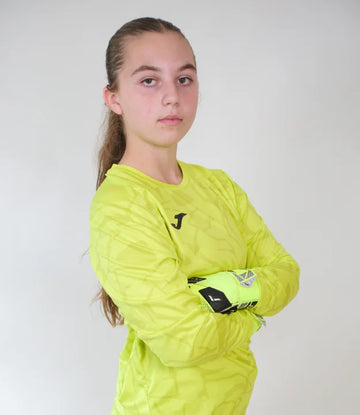
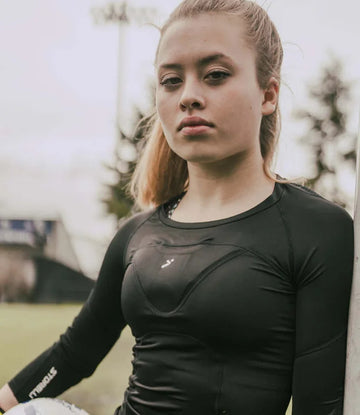
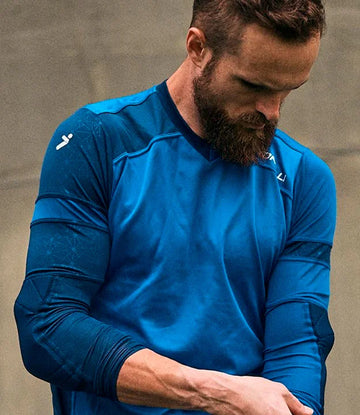
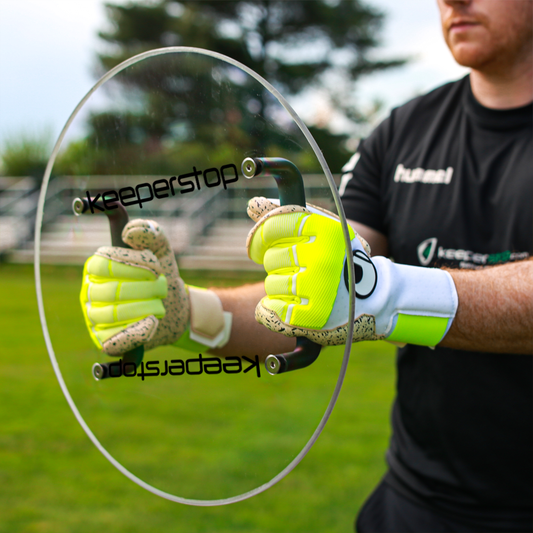
 Gloves
Gloves
 Jerseys
Jerseys
 Gear
Gear
 Brands
Brands
